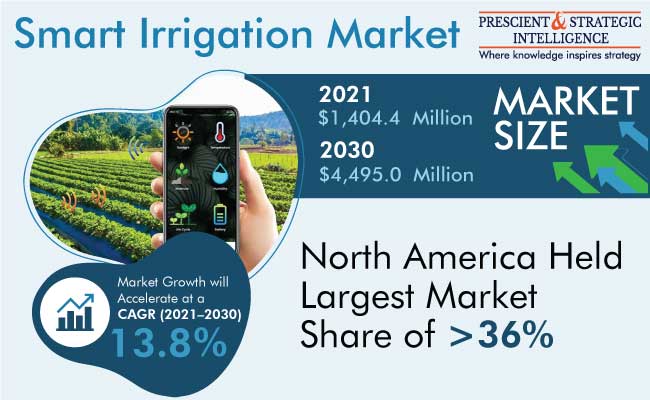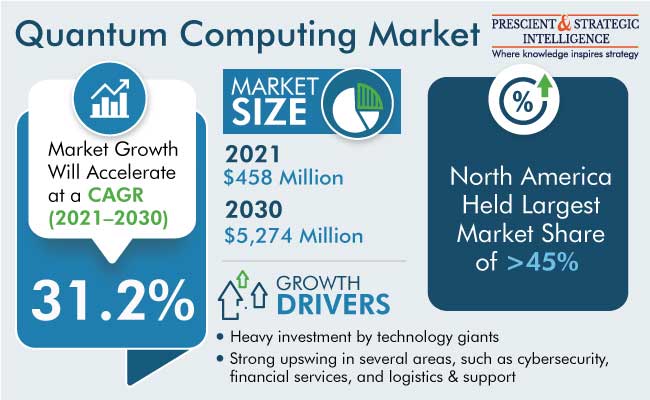North America Has the Highest Share of Over 36% in the Regional Market
In 2021, the total value of the smart irrigation market was $1,404.4 million, and it will grow at a rate of about 14% to reach $4,495 million in 2030. This has a lot to do with the augmented R&D activities and the increase in the acceptance of smart irrigation systems. Furthermore, extreme climatic conditions are prevalent indifferent nations. Irrigation systems must be extremely efficient in such areas, thus powering the demand for these systems.
Sensor-based controller systems will have rapid growth in the years to come. This is because of the increasing use of these systems in agriculture for saving water and boosting crop productivity. These can examine and control precise data from several sensors like the ones to sense temperature, moisture of the soil, precipitation, and humidity. Also, these sorts of systems are extensively preferred, as they are not dependent on weather station data or weather predictions.
Incessant progresses in communication technologies let farmers and household users to remotely control the irrigation systems. Wireless technologies are substituting conventional hardwire systems, as wireless sensors offer mobility, suitability, and further benefits. Irrigation systems make use of radio frequency technologies for communicating with wireless signal transmission networks. Therefore, technological progressions improve interoperability between the control center and the apparatus, increasing the general system efficiency.
Smart irrigation systems are extensively employed in agriculture land, sports grounds, golf courses, and housing areas. IoT-empowered smart irrigation systems help in the detection if water-level by robotically watering crops and others on the basis of moisture level of the soil, along with keeping track of the condition of the land. Furthermore, the increasing requirement for IoT and cloud technologies is credited to the increasing requirement for smart irrigation solutions.
The non-agricultural systems had the maximum demand in the past and it will maintain its position also in the near future. The augmented relevance of effective methods of watering and irrigation systems for non-agricultural purposes like residential, golf courses, and turf & landscaping is a main smart irrigation market driver.
North America had the largest share, of above 36% in the recent past. This has a lot to do with the stable rise in usable income, increase in urbanization, increase in acceptance of IoT-based irrigation approaches in Canada and the U.S., increase in smartphone penetration and other devices for accessing field info from remote locations, and augmented funding in the ag-tech industry.
Also, with the arrival of new agro technologies and devices, governments are trying to educate people about the correct usage of smart irrigation systems. Likewise, these are used to water fields and grounds, with golf course operators making use of smart irrigation to curtail their water usage. So, the above-mentioned whys and wherefores are helping the demand to increase in North America.
The increasing extreme water conditions have a lot to do with the increased adoption of these smart irrigation systems all around the world.
Read More: https://www.psmarketresearch.c....om/market-analysis/s


Quantum Computing Market To Observe Highest Growth Rate In Services Category
According to a statement by a market research institution, P&S Intelligence, the quantum computing market will propel at a 31.2% CAGR, to reach USD 5,274 million, by 2030.
The growth in the industry is credited to the deployment of such solutions which has resulted in strong improvement in numerous areas, for instance, logistics & support, cybersecurity, and financial services, as technology giants are investing heavily in this field.
In the past few years, the hardware category accounted for the largest share of the industry, at 62.5%. Players in the quantum computing industry are investing extensively in the advancement of strong hardware equipment, to assist such powerful software.
The services category is expected to advance at the highest growth rate in the industry, throughout this decade. This is credited to the enormous necessity for consulting and other related quantum computing support services in the years to come.
Based on application, the optimization category accounted for the largest quantum computing market share, 63.8%, in the past few years. This is because problems in most organizations revolve around streamlining business processes, and therefore, optimization solutions are of paramount importance.
In the past few years, the on-premises category, based on deployment type, accounted for the larger quantum computing industry share. This is attributed to the widespread research at the organizational or institutional level, for which this technology users prefer to store the information on their servers.
The BFSI industry generated the highest value in the industry of quantum computing, at approximately USD 145.4 million in 2021. This is because large banks are concentrating on investing in this technology to transform the processes of their business, as well as to gain stronger security.
The healthcare industry will propel at the highest growth rate throughout this decade. This is attributed to the growing demand for advanced diagnosis and treatment procedures for chronic illnesses.
In the past few years, the industry in North America accounted for the highest revenue, of USD 208.2 million in 2021. This is ascribed to the significant investments made by private and government organizations for the development of the technology.
Additionally, the government is the key driver behind the growing implementation of quantum computing, by investing in research and development. Moreover, the constant advancements in technology, early implementation of developing technologies, and high IT expenses drive the growth of the industry in this region.
It is because of the robust upswing in various areas, for example, logistics & support, cybersecurity, and financial services, and significant investment by technology giants, the industry of quantum computing will grow significantly in the years to come.
Read More: https://www.psmarketresearch.c....om/market-analysis/q
Why Choosing mPOS is the Right Thing to Do?
Accepting transactions with cards is nothing new for business in the current scenario. That traditional card swapping machine, connected through wire with phone is known as a traditional POS.
A traditional POS has several disadvantages, and the most notable is it being bulky. Well, in this blog, we will not talk about the bulky traditional POS, but its upgraded version, mPOS, and what are the various advantages in store for the same.
First let us know about the overall concept of mPOS
An mPOS is an alternative to the traditional POS connecting to smartphones through Bluetooth. It uses the data connection of mobiles for transaction processing. Just download the app, connect your mobile to the device, and just accept payments.
Now, we will talk about what advantages, mPOS has for you
On the Go Payments Made Possible
mPOS lets you accept payments on the move. No matter whether you are an an eCommerce business, with an option of card-on-delivery option or a restaurant accepting home delivery, mPOS can just work well.
It is an Affordable Alternative Than Its Traditional Counterpart
Setting up a traditional POS can be an expensive and time taking task to do. Instead, in the case of an mPOS, it is just the opposite, you can have the device on a rental basis for a much lesser cost compared to a traditional POS.
No Need for Specialized Technical Knowledge
There is no need for specialized technical knowledge for operating an mPOS. The software integrated in mPOS app is fairly user-friendly. So, they can be operated by a person even with a little to no technical knowledge. What it does is, it enables you to have more than one billing counter, which has these mPOS devices.
Maintaining an mPOS is Fairly Easy
If you are to train your staff about the repair and maintenance of a traditional POS device, it can really be a tiresome affair to say the least, and would also incur an extra cost. This is not the case with mPOS, just download the app and you are ready to go . The device is compact, and its maintenance is negligible. Just be sure to buy a device from a credible provider, and you can be sure about the quality.
It Possesses Integration Capabilities
mPOS device can be easily combined with your current bank account, and you don’t need to open a new account for the purpose of accepting card payments business. Apart from this, it is very easy to use and disregards the hassle of putting to use multiple devices.
mPOS is Completely Safe and Secure
mPOS is secure to use, and these devices have the highest transaction success rates to top it all. Also, with the help of geo-tagging facilities, mPOS devices allows to find the location, where the transaction takes place.
It is because of the increasing trend of cashless payments around the world, the demand for mPOS terminals is on the rise, and will continue the same way in the future.
Read More: https://www.psmarketresearch.c....om/market-analysis/m







